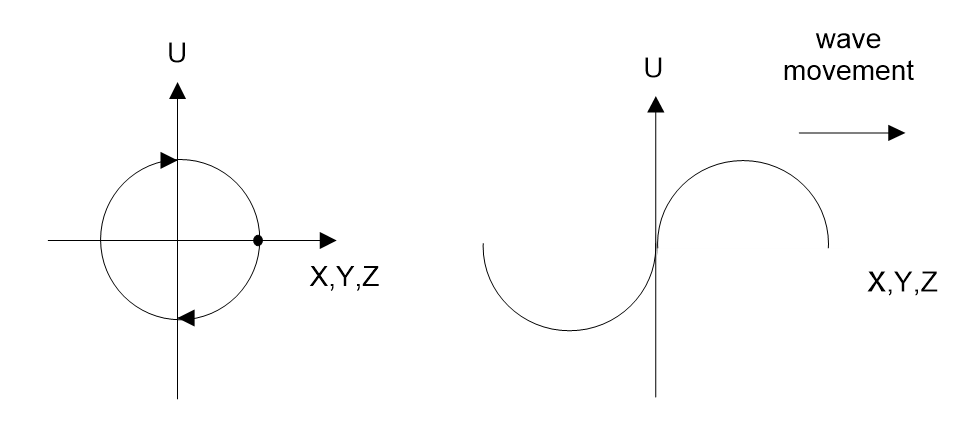Light travels in empty space but how can a transverse wave do that? Sound is also a wave, but there is no sound in empty space because there is nothing to transmit it. Yet light from the sun and stars still reaches us across the emptiness of space, so how can a wave do that without a medium?
Consider a wave travelling across a pool surface. The wave moves because the water moves, but a cork floating on the pool just bobs up and down as waves pass it. The waves don’t push the cork along because the water doesn’t move in the wave direction, it moves up and down. What moves as a wave isn’t the water, but it’s up-down surface displacement, so when a pebble drops on a still pool, that displacement spreads as waves. Waves spread when a surface vibrates up and down, so shouldn’t light be the same?
A transverse wave is one that vibrates at right angles to its movement direction. Water waves are transverse waves because the water moves up and down as the wave spreads horizontally. Light is also a transverse wave even though it moves in three dimensions not two. It is said to have no medium because materialism calls empty space nothing, but if space is a surface, then light could vibrate on space.
The theory of relativity agrees that our space is a surface because it lets space curve, and complex number theory adds that light vibrates in a dimension outside space. If these theories are correct, then the surface of space can host light as a transverse wave. Light travels in a vacuum, so it either vibrates nothing at all, which denies how waves work, or it vibrates something. The simplest option is that light is a vibration on the surface of space itself.
Why then don’t we see light waves moving up and down, as water waves do? We know that light vibrates, but a ray of light seen from the side doesn’t seem to move up or down. This is expected if the dimension into which light vibrates is sequestered from our space (Randall, 2005). Everything we see is based on light but a transverse wave can’t leave the surface it vibrates on, so we can’t use it to see what happens outside space. It takes reverse engineering to deduce that light vibrates on space.
But what exactly moves when light moves? According to physical realism, nothing can, but the alternative explored here is that the quantum network does. Maxwell’s equations describe light as an electromagnetic vibration orthogonal to space. Let this vibration be the quantum network setting a transverse circle of positive and negative displacements on the surface of space. If they complete at the same point in a cycle, it is a null process, or empty space, but the same process distributed over two or more points can be a wave of light (Figure 2.7). Chapter 3 gives more details, but essentially light is a positive-negative surface displacement, just as water waves are. What moves when light moves is then what we call quantum processing.

Quantum waves spread on the quantum network, and light is their simplest form, but what actually are they? Schrödinger called them matter density waves, because they predict where matter exists, but quantum waves aren’t made of matter. Born called them probability waves, because their amplitude squared at a point is the probability that matter exists there, but a probability is just a number. We expected the ultimate reality to be made of matter, but instead have found just waves. The quantum waves that predict physical events have no mass, momentum, velocity, or any other physical property, but they can manifest as space, light, and matter, as will be seen.